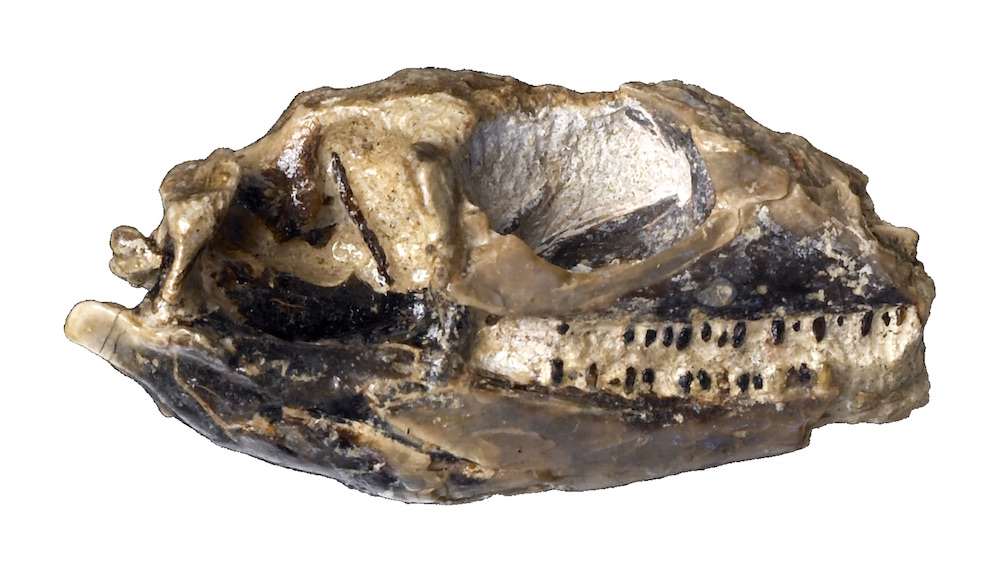Wild 'Jesus Lizard' Once Walked on Wyoming's Tropical Waters

About 48 million years ago, a distant relative of the "Jesus lizard," named for its knack for walking on water, darted around the tropical rainforests of ancient Wyoming, a new study finds.
The ancient lizard may have also performed the seemingly miraculous feat, though the researchers can't say for sure because they didn't find the animal's feet. From the fossil they did find — a skull with a toothy smile — in 2008, they posit the animal was likely the same size as a modern Jesus lizard — about 2 feet (0.6 meters) long from head to tail.
Wyoming is no longer home to wild Jesus lizards. These days, the reptiles live in the region spanning from central Mexico to northern Colombia, thriving in the higher temperatures near the equator, according to the study. [See Images of Modern and Ancient 'Jesus' Lizards]
But during the Eocene epoch, Wyoming was about 16 degrees Fahrenheit (9 degrees Celsius) warmer than it is now, and supported a lush, tropical climate, according to fossils of plants and other animals found in its deposits, said the study's researcher, Jack Conrad, an assistant professor of anatomy at the NYIT College of Osteopathic Medicine and a resident research associate of vertebrate paleontology at the American Museum of Natural History in New York City.
"During the Eocene, that part of the country was almost like a tropical rainforest," Conrad told Live Science. "There were lots of trees, freshwater lakes and rivers."
It's likely that the lizard moved southward as the climate in North America cooled, he said.
Conrad named the new species Babibasiliscus alxi — "babi" for the Shoshone word meaning "older male cousin" because it's the older relative of modern Jesus lizards, and "basiliscus" for the Jesus lizards' genus. The species name honors John P. Alexander, a former collections manager at the Burke Museum at the University of Washington, who found the fossil.
Sign up for the Live Science daily newsletter now
Get the world’s most fascinating discoveries delivered straight to your inbox.
B. alxi may be the earliest member of the Jesus lizard group, Corytophanidae, which includes iguanas and chameleons, Conrad said. Fossils that would reveal the evolutionary history of Corytophanidae are sparse, as most of the ancestors lived in tropical areas, where conditions are not optimal for fossilization. (For instance, minerals needed to fossilize a specimen are usually "recycled quickly" by the rainforest, said Randall Nydam, a professor of anatomy at Midwestern University in Arizona, who wasn't involved in the study.)
Given the limited fossil record, B. alxi may just be a distant relative, and not the earliest member of the group, Nydam said.
Water walker
The ancient lizard likely spent most of its time in the trees, much like its modern relatives, said Conrad, who has seen wild Jesus lizards in Guatemala.

"They have very large feet, and they're able to move their legs very quickly," he said. "They're able to use just the surface tension of water to flap their foot on the water and pull up before the water closes around the toes."
It's possible the ancient lizard also skimmed across the water in ancient Wyoming, he said.
A computerized tomography (CT) scan of the fossil showed that it has a healed fracture on its jaw. The fracture would have made it challenging for B. alxi to hunt, since many lizards use their faces to attack prey, Conrad said.
"This is a pretty severely broken jaw based on what we can see in the CT scan," Conrad said. "It usually takes a pretty hardy animal to survive something like that."
Other aspects of the skull shed light on the lizard's life. It had a bone ridge that would have made it look constantly angry (much like a bald eagle) but would have shaded its eyes from the sun, Conrad said.
B. alxi also had small teeth with three distinct cusps that would have helped it eat snakes, lizards, fish, insects and plants, Conrad said. Its large cheekbones may have helped it capture larger prey, he added.
The fossil is a rare find, Nydam said.
"It's filling in a record that I think needs a lot of attention," he said. The fossil adds evidence that Corytophanidae lizards lived at northern latitudes during the Eocene, and "helps to explain how [they] ended up in Central and South America," he said.
The findings were detailed online today (July 1) in the journal PLOS ONE.
Follow Laura Geggel on Twitter @LauraGeggel. Follow Live Science @livescience, Facebook & Google+. Original article on Live Science.

Laura is the archaeology and Life's Little Mysteries editor at Live Science. She also reports on general science, including paleontology. Her work has appeared in The New York Times, Scholastic, Popular Science and Spectrum, a site on autism research. She has won multiple awards from the Society of Professional Journalists and the Washington Newspaper Publishers Association for her reporting at a weekly newspaper near Seattle. Laura holds a bachelor's degree in English literature and psychology from Washington University in St. Louis and a master's degree in science writing from NYU.









